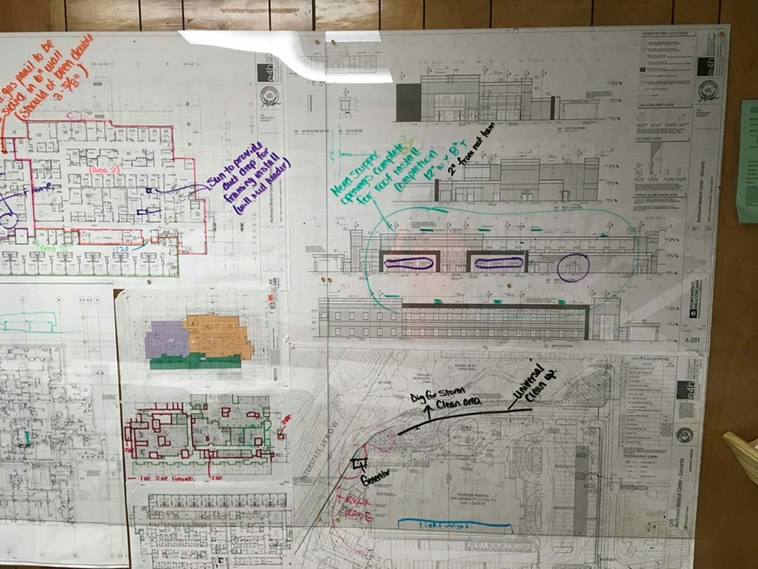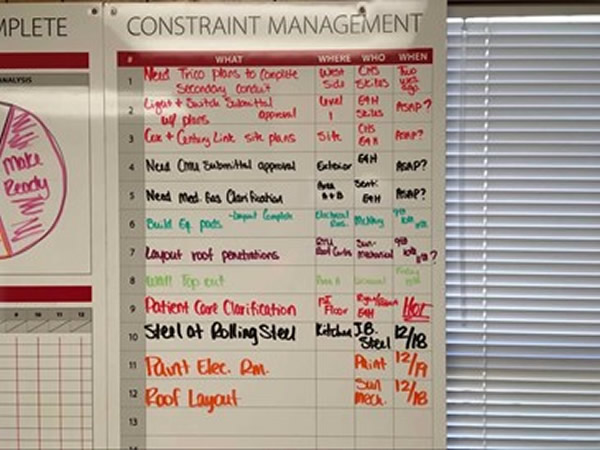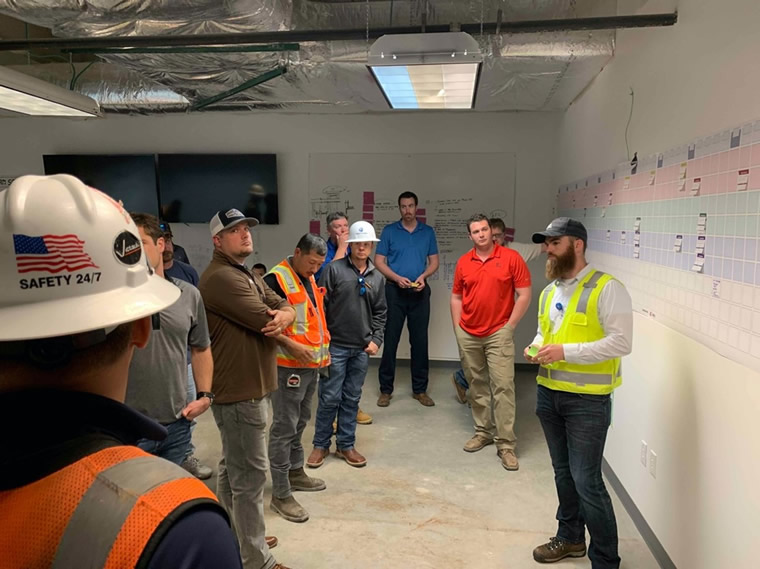Lean Tools such as pull planning, constraint management, and visual communication boards will go a long way to help in the implementation of The Last Planner System. Lean construction expert and author Keyan Zandy explains.
Lean Tools
Our motivation with The Lean Builder is to explain the concepts, tools, and principles of Lean in an easy-to-understand manner based on our experience with the realities of day-to-day life on the jobsite. Our hope is that you can add Lean tools to your tool belt that will create a culture of continuous improvement and improve production and workflow, giving you hours back in your day. If you’re new to Lean, sold on the benefits, and feel ready to make the leap, then here is how you should start.
1: Move to a Daily Huddle
Are your subcontractor/field coordination meetings unproductive? Do the foremen seem disengaged? Do topics take too long to work through? Consider switching to a daily huddle, as well as these practices:
- Set a Timer—A huddle should last no longer than 15 to 20 minutes. If you go longer than that, you risk losing the attention and engagement of the participants.
- Start and End on Time—Punctuality makes a good first impression, fosters productivity, establishes routine, builds trust, and shows you value everyone’s time.
- Phones Off—Everyone should be present. Allowing participants to use their phones shows a lack of respect by implying that whatever is on the device is more important than the people and the conversation in the room.
- No Chairs—Keep everyone standing. This helps maintain focus on the discussion at hand.
- Two-Minute Rule/Parking Lot—If an issue has been discussed for more than two minutes, it should be set aside and resolved later. Write down this topic on a list titled “parking lot” for a discussion following the huddle with only the people who need to be involved, as opposed to the entire team.
To learn more about daily huddles, read 7 Rules for a Great Daily Huddle
2: Employ Visual Communication Tools
Visual communication tools play a very important role in establishing and maintaining reliable workflow in the field. When communication breaks down, teams experience loss of productivity, hindered completion times, and costly errors. Visual communication tools significantly help bridge communication gaps and facilitate better trade-to-trade collaboration at the morning huddle.
Purchase clear laminate and a pack of colorful dry erase markers, and then designate a different color per trade. Mount your floor plans and elevations under the laminate on a wall, and have the trade partners both verbally and visually show the team the following items during the daily huddle:
- WHAT they are working on
- WHERE they are working
- HOW MANY crews/workers they have on-site
- where CONSTRAINTS are
- what MATERIAL DELIVERIES are scheduled
Make sure that your visual tools are easy to set up, see, update/maintain, use and understand.
To learn more about visual communication tools, read 6 Visual Communication Tools to Transform the Jobsite
3: Managing Constraints
If you find it difficult to understand, organize, and resolve issues in an effective or timely manner, a constraint board can help. This powerful tool helps the team communicate, prioritize, and track the constraints that invariably arise during construction. If you’d like to implement a constraint board, all you need is dedicated whiteboard space or a large sheet of paper. Create a chart with the following four columns:
- WHAT?
- WHO?
- WHERE?
- WHEN?
WHAT refers to what the constraint is, while WHERE asks where it is occurring. When a trade partner brings up a new constraint in the daily huddle, it’s important to not get too deep in the details. The huddles are fast-paced, and a lot of time can be spent in describing a constraint and its implications. It is best to just quickly capture WHAT and WHERE, and then move on.
As for WHO, it asks who is responsible for getting a solution, and WHEN refers to when do they commit to having it complete. The WHO and WHEN columns must be filled out at the huddle with the trade partners. This is the commitment portion of the constraint board: assigning responsibility to someone and making a promise about when it will be resolved. This practice adds strong layers of accountability to the team.
At the daily huddle, ask your team to write their constraints on the board. This allows the trade partner with the constraint to feel heard and serves to shift the project’s culture into one where the trades collaborate and resolve their issues together, rather than making the superintendent the middleman.
Removing Constraints
Only the person who initiated the constraint should be allowed to remove it. This allows the initiator to maintain ownership and prevents it from being removed by someone who may not have all the necessary information.
This constraint process will be tough for some team members to acclimate to, as many are not used to this level of transparency or accountability. Use empathy with your team when challenges or conflicts arise, as those individuals are often in an overextended state.
To learn more about managing constraints, read Constraint Management Techniques on the Jobsite
4: Implement The Last Planner® System
Once you feel that your team is having a strong daily huddle where visual communication tools and a constraint board have been implemented, it is time to move on to the Last Planner System, or LPS. This can be overwhelming at first; however, once you begin this journey and start leveraging the power and efficiency of this operating system, you will create significant value for yourself and your team.
The beauty of this operating system is that it allows the field leaders closest to the work to plan the work. These leaders are the last planners.
The Five Components of The Last Planner System
The Last Planner System is holistic, and all facets of it must be utilized to leverage its maximum potential. It is broken out into five components:
- Master Scheduling
- Phase Scheduling
- Look Ahead Planning
- Weekly Work Planning
- Percent Plan Complete
Master Scheduling
Master Scheduling is what most of us in the industry have done for years: building a project schedule from start to finish and identifying the project milestones. These schedules are typically built by the general contractor, often with little or no input from the trade partners.
In our business, most contracts are signed between an owner and a general contractor based on the Master Schedule. The main issue in our industry is that this is usually where the scheduling process stops. The general contractor will either issue this same schedule, no schedule, or a shortened schedule to the trades without asking for their input. The Last Planner System changes this status quo with the next component, Phase Scheduling.
Phase Scheduling
Phase Scheduling is collaborative planning which produces better schedules because the schedule is being built, collectively, by the experts who will perform the work. With the benefit of the trade partners’ input and buy-in, phase scheduling is a game-changer when it comes to building a reliable schedule.
Pull Planning is a Lean tool that last planners will leverage during the phase scheduling component of the Last Planner System. Pull planning and phase scheduling are often referred to as one and the same; however, the pull plan is the vehicle or process that drives the collaboration and reliable commitments at this stage.
To learn more about how to implement a pull plan, read 4 Best Practices for Your Next Pull Plan Session
Look-Ahead Planning
Look-Ahead Planning, is the next step in the system. After the pull plan, the general contractor will update the master schedule with the activities and durations committed to by the last planners. When completed, the general contractor will issue a six-week look-ahead to the team. This gives the team a road map of the upcoming work and allows the last planners time to identify and clear constraints that might slow down or prevent upcoming work from being completed as planned. This allows the team to review the upcoming six weeks, every week.
The six-week schedule could be produced as a Gantt chart from scheduling software, or in Excel where you can break out work by trade, color code activities, add a constraint column, etc. It is important that the six-week look-ahead is updated with what is going on in the field, and that it is sent to the trades each week.
Weekly Work Planning
Weekly Work Planning, also known as commitment planning, will be the differentiating factor in your daily huddle meetings once the team is bought into the collaborative process. A Three-Week Look-Ahead board can be introduced into the daily huddle meeting as a dashboard tool to keep everyone on track.
To learn more about how to implement a weekly work plan in your daily huddle, read Last Planner System Implementation in Construction
Percent Plan Complete
The Percent Plan Complete (PPC) portion of the Last Planner System is often overlooked by many project teams who think of the Last Planner System as an à la carte menu—selecting a little pull planning here and a little look-ahead planning there. However, the Last Planner System is not designed in this manner. It is a holistic system, and Percent Plan Complete happens to be one of the most important parts of the Last Planner System, as it is the learning opportunity, the chance to get better as a team and shore up the commitments to be more reliable.
To learn more about Percent Plan Complete and Root Cause Analysis, read: Lean Construction Practices – Percent Plan Complete
At the beginning of your journey, we strongly encourage you to start slowly. Lean concepts are simple, but implementation is not easy. You will fail a time or two, trade foremen will push back—and when things on your project get tough, it will be very easy to go for the escape hatch and return to what is familiar. Remember the big picture and why you are implementing these changes in the first place. Keep your head up and stay the course.












